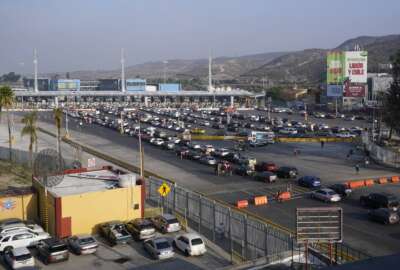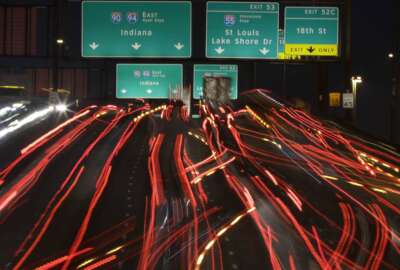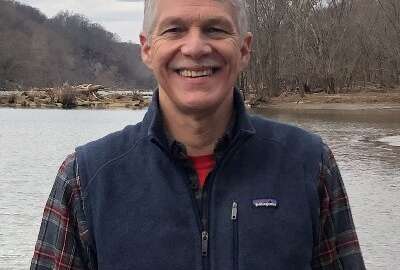They helped write a big law and now they help to carry it out
Somebody had to actually write the trillion dollar infrastructure bill back in 2021. Its proponents expect it to help modernize old bridges and highways, among...
Somebody had to actually write the trillion dollar infrastructure bill back in 2021. Its proponents expect it to help modernize old bridges and highways, among other things. The Federal Drive with Tom Temin‘s guests helped Congress craft the bill. Now they’re leading the Transportation Department team helping to implement it. For their work, they won this year’s Service to America medal for management excellence. Gloria Shepherd is Executive Director of the Federal Highway Administration and Maria Lefevre is the Executive Director of the Office of the Undersecretary of Transportation.
Interview Transcript:
Tom Temin All right. Let’s talk about the background here. Everybody talks about infrastructure. You folks deal with it as we understand it. Those of us that drive, take airplanes, take trains or whatever the case might be. What was the process like? Describe what it was like working with Congress, who actually has to craft this into language? What did you bring to them that helped them craft this bill, Maria?
Maria Lefevre Sure. Any legislation, we oftentimes help Congress through what’s called technical assistance. And we get a lot of questions from Capitol Hill. Both sides of the aisle is asking are able to implement something and how we would implement if, you know, the language they sent us works that way. So with countless hours of back and forth with our colleagues on the legislative side to continue to put great ideas into a bill that ended up coming to fruition.
Tom Temin All right. And Gloria, everybody talks about the roads and the bridges and we all encounter the ones we encounter. And some of the bridges are rickety and some of the roads are breaking up. Does the Federal Highway Administration, did you bring to this some kind of an organized knowledge of where the problem areas actually are?
Gloria Shepherd FHWA has 52 divisions, one division in every state, including one in Puerto Rico and D.C. So when a congressional official or a senator or whomever calls and asks about a specific issue in their state, we are able to reach out to our division and get firsthand knowledge on what the situation is and be able to provide them with technical assistance if they want, on how to fix the problem.
Tom Temin Now, a certain part of this bill is in fact devoted to the railroads and the highways and so forth. And as you point out, a lot of the roads come under state jurisdiction. Did you also have an idea of what the cost for the priority projects would add up to? You know, the bill was a trillion dollars. But that’s just an arbitrary number. It sounds like you must have had to help them shape that number. That would be for the infrastructure that the FHA oversees.
Gloria Shepherd Yes, we have a national bridge inventory system and we have a pavement inventory system. And we also work with the states on what we call their state transportation implementation program. And in those programs are a list of projects that the states plan to implement over a period of time. So we look at each state and what we call STIP. We have an idea of what the state is contemplating for the next at least four years. And if we look at the metropolitan long range plan, that plan can be no less than 20 years. So we could see what they’re planning out for in the future. So we get an idea by calculating those costs to see what’s necessary or what’s required in order to put those projects and implement those projects and put the system, transportation system back in a good state of repair.
Tom Temin Okay. And, Ms. Lefevre, you must have a view of everything that’s not a road. That is also infrastructure. How did the airport situation, the landing and whatever else is there, and all of the railroad infrastructure, which is private sector in some areas, its public sector in other areas. Sounds like a complicated thing to get a handle on.
Maria Lefevre Certainly. And similarly, we have an idea of backlog of rolling stock in others. And for rail, the rail system that needs to be upgraded and the backlog of upgrades and then the new discretionary grant programs that we in Congress will be contemplating. So we had numbers. You have the regular authorization or reauthorization for a five year bill and add new discretionary grant programs or enhance the ones that we have with a larger dollar amount and try to fill in the gaps of the backlog of maintenance and growth. And we’re working toward a really big number that we needed to get to to bring transportation system to the 21st century and beyond to help it grow, sustain and remain the safest transportation system in the world.
Tom Temin By the way, is the Baltimore Tunnel part of the project. Is that we’re going ever see a new tunnel there?
Gloria Shepherd If the state puts that on their plan, then, yes, you will see it. But we rely on the state to identify what infrastructure needs repair and when it needs to repair.
Tom Temin Sure. We’re speaking with Gloria Shepherd. She’s executive director of the Federal Highway Administration. And with Maria Lefevre, executive director of the Office of the Undersecretary of transportation. They, along with the Office of Railroad Development’s Paul Nissenbaum, are winners in this year’s Service to America Medal for Management Excellence. And now that the bill is passed, it’s been around a couple of years. What are you seeing in terms of applications, the workload? Give us an update on the implementation of actually fixing infrastructure. Ms. Shepherd?
Gloria Shepherd The workload has increased significantly because of the bipartisan infrastructure law. The states receive loans two ways; through their formula funds that goes directly to them. And as Maria mentioned, through discretionary programs. Well, we have a significant number of discretionary programs. Our last significant effort under the law was completed by September 30, when we allocated $61 billion in apportionment for 12 formula programs for fiscal year 2024, the third year of funding under the legislation. The $61 billion in funding represents an increase of $17.6 billion in formula programs. The other thing I would like to just point out that even though we do highways and bridges and we do concrete, asphalt and steel, this law is not only about those kinds of transportation projects. This law is what brought it us with an opportunity to work on historic initiatives, including supporting transportation safety. And Maria will tell you that safety is the premier focus for every mode in USDOT. It also enhances equity by reconnecting communities that were previously divided by transportation infrastructure and implement electrification, which will help reduce our country’s carbon footprint and a strengthening supply chain. So we get a chance, as Maria mentioned, to work on a lot of different type of projects than wehad before, like reconnecting communities. So this law is pretty expansive and not just about asphalt, steel and concrete.
Tom Temin Yeah, I remember. Those can be powerful projects. I remember there was a town called Milton in Massachusetts cut in half by the South East Expressway in the late 1950s, and finally they bridged it over and a whole community kind of came back together. So a lot of call for this kind of thing. Maria, tell us more about the safety aspects and are, for example, certain areas that have been maybe don’t need rebuilding physically but have been deemed unsafe, will get some kind of a facelift to make them safer?
Maria Lefevre Absolutely. And in regards to the numbers as well, we’re seeing that discretionary grant programs as well. We put out a notice of funding opportunity. They are still being over. That means more applications than money that is there. And we still have to make a discretionary decision. But one of the main decisions that Secretary Buttigieg to make on those applications is safety. And safety is, again, the criteria of those discretionary. And even if a community feels that something is not safe or not just a bridge, but a grade crossing, we are making sure that we are prioritizing those applications as they come in and go through an extensive evaluation. And, you know, we’re helping with crossings, even if it’s a bridge or put it in a roundabout instead of a a stoplight or a stop sign and making every day safer for the American user.
Tom Temin All right. And as people who spend their lives in the transportation domain, this must seem like a little bit of seventh heaven to you, even though there’s a lot of work.
Maria Lefevre Well, it is.
Gloria Shepherd It is an honor. It’s a tremendous honor. And we thank the Secretary and the Deputy Secretary. And Carlos Monje, who Maria works directly for. But I want to point out, Maria and I answer these questions. We say we and we is an important word to us because we are the faces of the award. But there’s a lot of other people. We have, FHWA has up close to 2800 people. And all those people work to deliver the programs on a day to day basis that affects the American people’s lives and promote safety and other priorities. So we means everyone who has worked on this bipartisan infrastructure law.
Tom Temin Okay. And final word, Maria.
Maria Lefevre I’ll second that. And we’re just the faces of this wonderful humbling award. And as you know, there’s 55,000 people at DOT, and in some ways, some structure, they’ve all touched this wonderful bill. It’s not only creating jobs within DOT, it’s creating thousands of jobs outside of DOT
Copyright © 2025 Federal News Network. All rights reserved. This website is not intended for users located within the European Economic Area.
Tom Temin is host of the Federal Drive and has been providing insight on federal technology and management issues for more than 30 years.
Follow @tteminWFED






